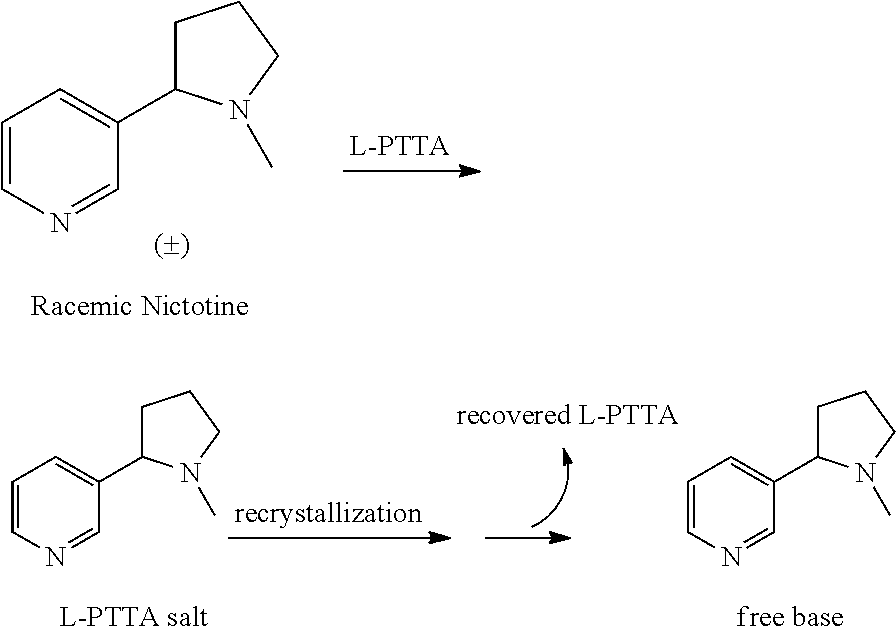Synthesis and resolution of nicotine
a nicotine and synthesis technology, applied in the field of synthesis of nicotine and nicotine resolution, can solve problems such as racemic mixtures
- Summary
- Abstract
- Description
- Claims
- Application Information
AI Technical Summary
Benefits of technology
Problems solved by technology
Method used
Image
Examples
example 1
Nicotine Synthesis
[0027]Synthesis of Compound 1
[0028]
[0029]A 50-L, 4-neck round-bottom flask was equipped with a mechanical stirrer, a condenser with an N2 inlet, a thermowell, and an addition funnel. The flask was charged with 1.96 kg of potassium tert-butoxide (KOtBu) (16 mol, 1 equiv.) in 24L of toluene at room temperature (˜20° C.). A white suspension was observed. N-methyl pyrrolidone (1.49 kg, 15 mol, 1.03 equiv, 1.45L) was added and stirred for 15 minutes. A pale yellow suspension was observed. Methyl nicotinate (2 kg, 14.6 mol, 1 equiv) was added slowly as a solid over 30 minutes. A thick yellow suspension was observed. An additional 6L of toluene was added to obtain good mixing.
[0030]The reaction mixture was heated to reflux over 1 hour at 102° C. and refluxed for 3 hours. A vigorous reaction was observed with an internal temperature of about 100° C. The heat source was removed to control the exothermic reaction and a pale yellow thick suspension was observed. After 3 hours...
example 2
Resolution of Racemic Nicotine
[0037]The following chiral HPLC conditions were used in all analyses: column: Chiralcel® OJ; flow rate: 1.7 mL / min; temperature: ambient; mobile phase: 95 / 4.98 / 0.02 hexanes / MeOH / trifluoroacetic acid (TFA), mixed by the HPLC pump from separate bottles of hexanes (95%) and 0.4% TFA in MeOH (5%). (Note: To ensure quality peak shape, the MeOH / TFA solution should be made fresh daily, each solvent thoroughly de-gassed, and the column given ample equilibration time (˜1-2 hours).) HPLC samples were prepared as solutions of the free base in reagent alcohol (e.g., 2-5 μL injections of 5-10 mg / mL sample solutions). The free base was prepared by partitioning the salt in 1M NaOH / DCM, separating the DCM layer, drying with MgSO4, filtration, DCM evaporation, and at least one co-evaporation with reagent alcohol to ensure complete DCM removal prior to subjection to the chiral HPLC column. Lastly, the sample solutions were filtered through 0.2 micron filters prior to HPL...
PUM
| Property | Measurement | Unit |
|---|---|---|
| pH | aaaaa | aaaaa |
| pH | aaaaa | aaaaa |
| molar ratio | aaaaa | aaaaa |
Abstract
Description
Claims
Application Information
 Login to View More
Login to View More - R&D
- Intellectual Property
- Life Sciences
- Materials
- Tech Scout
- Unparalleled Data Quality
- Higher Quality Content
- 60% Fewer Hallucinations
Browse by: Latest US Patents, China's latest patents, Technical Efficacy Thesaurus, Application Domain, Technology Topic, Popular Technical Reports.
© 2025 PatSnap. All rights reserved.Legal|Privacy policy|Modern Slavery Act Transparency Statement|Sitemap|About US| Contact US: help@patsnap.com



